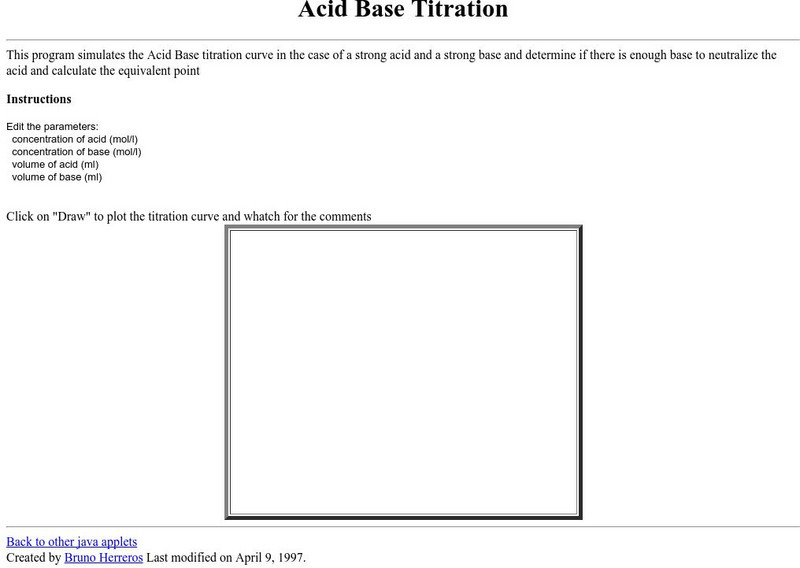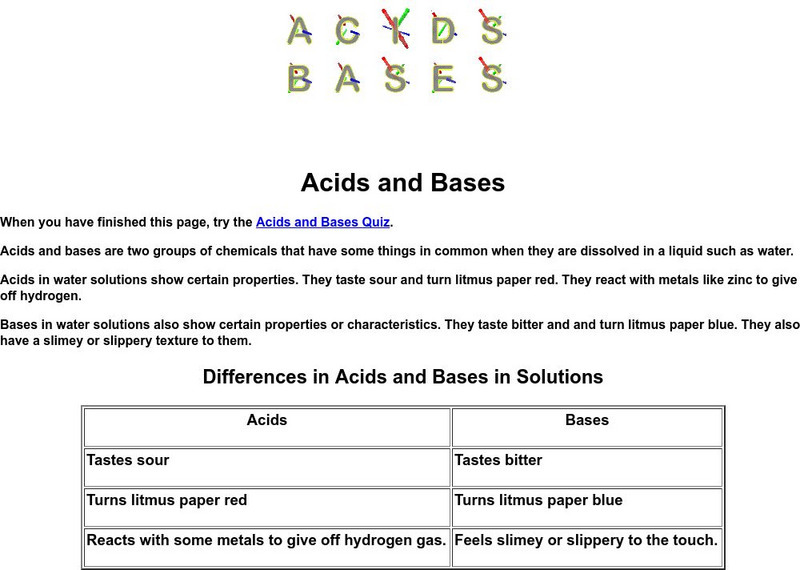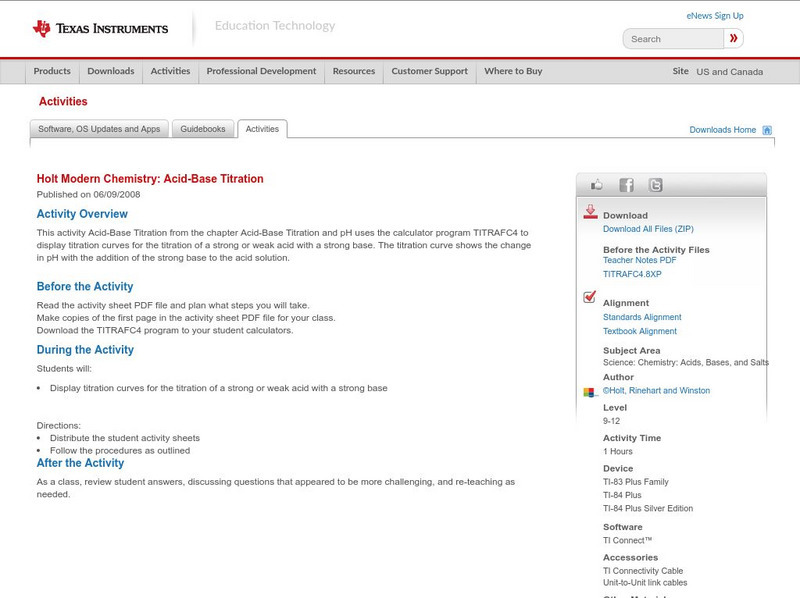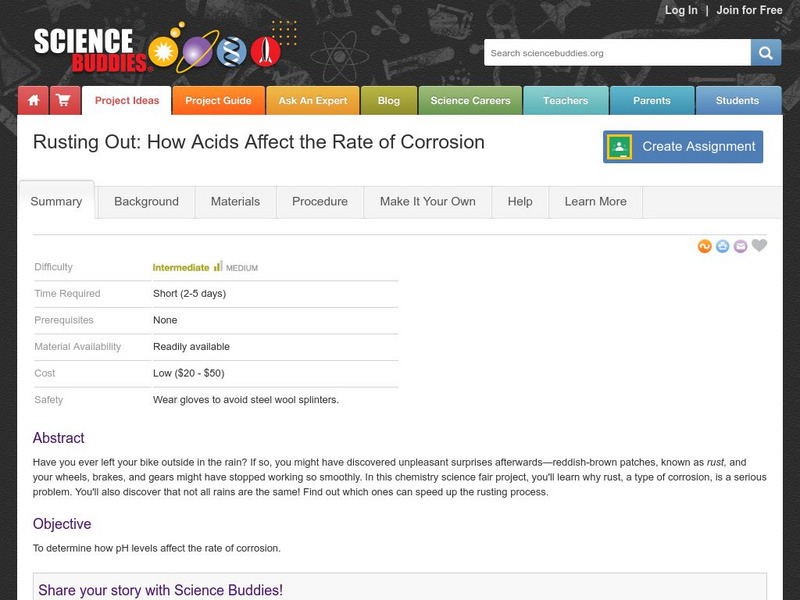Hi, what do you want to do?
Curated OER
Chemicals in Your Life
In this chemicals activity, students fill in 61 blanks of statements comparing the chemicals used in farming and the chemicals found in medicines and food.
Curated OER
pH and Titration
For this pH worksheet, students review the titration procedure and the significance of the stoichiometric point. This worksheet has 2 problems to solve.
Curated OER
Heat of Formation
In this reactions worksheet, learners calculate the heat of reaction for given chemical reactions. This worksheet has 3 problems to solve.
Curated OER
Stoichiometry Homework
In this stoichiometry worksheet, students determine how much reactants are necessary to complete the given chemical reactions. This worksheet has 4 problems to solve.
Curated OER
Molecular Evolution in Plants
High schoolers examine chlorophylls. They explore the absorbing pigments in a variety of plants. Through activities, students determine spectrophotometrically. They compare plant proteins from the family Brassicace to assess the level...
Georgia Department of Education
Ga Virtual Learning: Ap Chemistry: Acid Base and Solution Equilibrium
Through a variety of activities, students learn that not all acid and base reactions go to completion, and instead, they establish equilibrium. Acid-base equilibrium expressions have their own constants, ka and kb. Students will perform...
Georgia Department of Education
Ga Virtual Learning: Chemistry: Acids, Bases, and Salts
An interactive module where students build upon the discussion of solutions, but specifically concentrate on special types of solutions, acids and bases.
University of Southern California
Usc Chemistry: Acid Base Titration
This java site allows students to enter the concentration and volume of the base and acid and see the titration curve that is produced.
Other
Mountain Empire Community College: Biology and Chemistry: Acids and Bases
Learn how acids and bases are defined. Also read about examples of each and their chemical reactions.
Wyzant
Wyzant: Acids and Bases
This site presents everything you need to know about acids and bases and more! Gives a nice description on what acids and bases are, properties of both, strong and weak acids and bases, an overview of pH, and much more.
Other
Mcwdn: Chemistry: Acids and Bases: Differentiating and Quiz
Learn what distinguished an acid from a base. Then take a brief quiz to assess your new knowledge on the topic.
Chiral Publishing
Chiral Publishing: An Introduction to Chemistry: Acids, Bases, and Acid Base Reactions [Pdf]
Find out everything you ever wanted to know about acids, bases, and acid-base reactions! This in-depth chapter discusses how to name these compounds and how they form solutions.
Chiral Publishing
Chiral Publishing: An Introduction to Chemistry: Acids, Bases, and Acid Base Reactions: Study Guide [Pdf]
Use this comprehensive study guide to review everything about acids, bases, and acid-base reactions. This will help you prepare for tests and quizzes.
Texas Instruments
Texas Instruments: Holt Modern Chemistry: Acid Base Titration
This activity Acid-Base Titration from the chapter Acid-Base Titration and pH uses the calculator program TITRAFC4 to display titration curves for the titration of a strong or weak acid with a strong base. The titration curve shows the...
Chiral Publishing
Chiral Publishing: An Introduction to Chemistry: Acids, Bases, and Acid Base Reactions: Power Point [Pdf]
Use this PDF as an overview for everything acids and bases. Basic information, charts, and pictures will help you to review this information.
Chiral Publishing
Chiral Publishing: An Introduction to Chemistry: Acids: Audio Book
This audio book presentation provides basic information on acids. Learn about characteristics of acids, types of acids, and reactions with acids.
Chiral Publishing
Chiral Publishing: An Introduction to Chemistry: Acids and Bases
See how much you know about acids and bases through this fun tutorial. Practice matching the names or formulas to the correct category of acids or bases.
Chiral Publishing
Chiral Publishing: An Introduction to Chemistry: Acids
Fascinating animation of what happens when acids dissolve in water. See how particles collide on a molecular level in this colorful, easy to understand depiction.
Royal Society of Chemistry
Royal Society of Chemistry: Gridlocks: Level 1
A collection of grid puzzles that cover topics in basic chemistry, including acids, salts, alkalis, chemistry lab equipment, the periodic table, states of matter, and more. These are excellent for topic review and reinforcement. The...
Science Buddies
Science Buddies: Project Ideas: How Acids Affect the Rate of Corrosion
In this chemistry science fair project, students will investigate how pH levels affect the rate of a common form of corrosion, called rusting. The Science Buddies project ideas are set up consistently beginning with an abstract,...
Science Buddies
Science Buddies: Cabbage Chemistry
This experiment is for all the kids out there who love boiled cabbage. Even if you don't like cabbage, perhaps you will like this amazing color-changing liquid you can make with cabbage. You'll learn which solutions around your house can...
CK-12 Foundation
Ck 12: Acids and Bases
[Free Registration/Login may be required to access all resource tools.] In the following online tutorail students will define acids and bases in terms of the ions that are produced when each type of compound is dissolved in water. They...
Vision Learning
Visionlearning: Chemical Relationships: Acids and Bases
An explanation of historical ideas that lead to the current day concepts of acids and bases. The Concept of pH is briefly introduced.
CK-12 Foundation
Ck 12: Nucleic Acids
[Free Registration/Login may be required to access all resource tools.] In ths module, discover the structure of a single nucleotide and how that structure leads to the overall structure of DNA and RNA.
Other popular searches
- Chemistry Acids and Bases
- Acid Base Chemistry
- Acid Bases in Chemistry
- Acid Base Chemistry Labs
- Review Acid Base Chemistry
- Kitchen Chemistry Acids
- Acid and Base Chemistry
- Chemistry Acid Alkali
- Ap Chemistry Acid
- Chemistry Acid Base Puzzle
















![Chiral Publishing: An Introduction to Chemistry: Acids, Bases, and Acid Base Reactions [Pdf] eBook Chiral Publishing: An Introduction to Chemistry: Acids, Bases, and Acid Base Reactions [Pdf] eBook](https://static.lp.lexp.cloud/images/attachment_defaults/resource/large/FPO-knovation.png)








